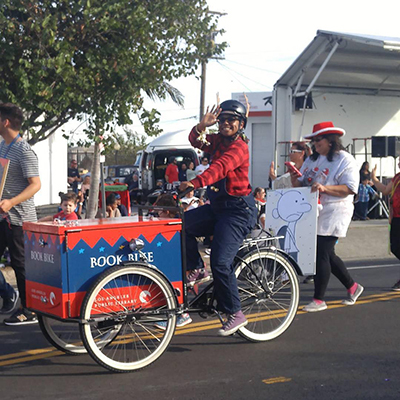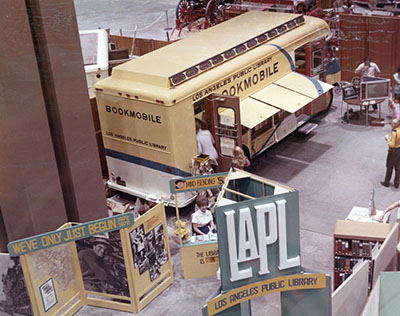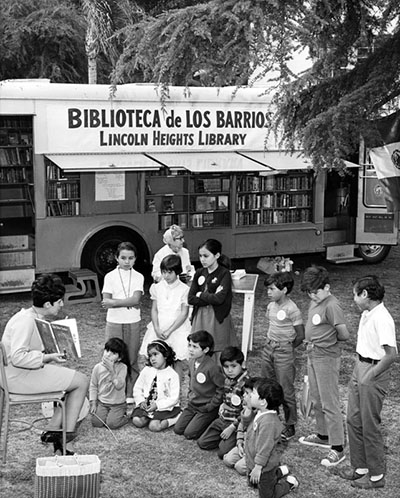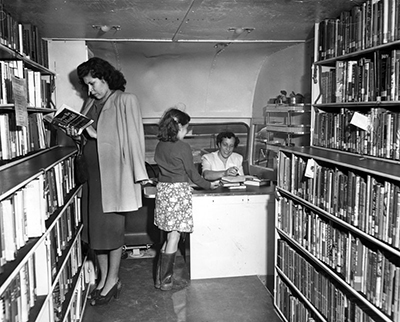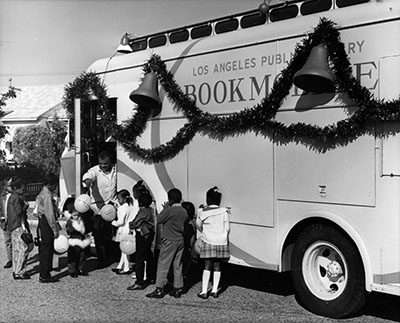Today is National Bookmobile Day, a day to celebrate the contributions bookmobiles make to their communities. From 1949 to 2004, Los Angeles Public Library’s bookmobiles made a significant impact in the community by visiting lots of neighborhood schools, parks, and housing developments around the city. Their success helped shape the libraries we visit today.
The goal of a library is to provide the best possible service to everyone within their service area, and sometimes that mission needs wheels. During the Great Depression, the Los Angeles Public Library researched bookmobile service at other libraries around the country. The steady population growth of Southern California meant the library needed to provide widespread service to parts of the city that were still growing. In 1948, a 12-volume report by the Los Angeles Bureau of Budget and Efficiency surveyed services of the Los Angeles Public Library and reinforced the decision to proceed with a bookmobile purchase. At that time, areas of the city that did not meet the population requirements for a full branch had library stations instead. These small stations were usually in rented buildings and offered a small number of books for loan, typically 100 to 1000 popular titles. Library stations had limited hours of operation and relied on volunteers or staff that lacked proper training. By using bookmobiles, or Traveling Branches, the library would eliminate the need to rent a location, assure that a librarian was always available, offer more books than the number available at library stations, and most importantly, expand service to a larger geographic area.
By mid-century, the flexibility offered by bookmobiles was an advantage in many areas of the rapidly developing city. The expansion of aerospace and shipbuilding industries during World War II helped spur this growth. For example, because of the aerospace industry, Westchester’s population grew more than 75% from 1940-48. The San Fernando Valley, which is comprised of more than 200 square miles of previously agricultural land, saw a housing boom after World War II. Some areas, such as Reseda and Van Nuys, were densely populated, while other areas remained rural. Traveling Branches allowed for location changes based on demand.
The opportunity to make the library more accessible to children was an important goal as well. According to the library’s annual report for 1944-45, the children’s department at Central Library began their own mobile service in the early 1940s using a station wagon to provide materials to children at schools that lacked nearby libraries. Additionally, as the 1948 survey noted, Los Angeles was full of geographical and physical barriers that made it a hazard for children to visit their local library. Streets crowded with automobiles and streetcars were especially difficult to cross safely.
Two book-filled vans, one of which stocked only children’s books, finally hit the road in May 1949. Each van carried at least one librarian, support staff, and a driver. During the first few months, the bookmobile carrying both adult and children’s materials visited eight locations weekly. These locations included two temporary veteran housing developments: Basilone Homes, which was near Hansen Dam, and Rodger Young Village, located on what is now the LA Zoo parking lot. In addition, there was the Richard Neutra-designed Channel Heights housing development for shipyard workers in San Pedro, and several elementary schools in the San Fernando Valley. Within the first three months, 19,206 books were checked out across those eight bookmobile stops. The other bookmobile, possibly the first devoted solely to children, carried books to 18 schools near downtown Los Angeles. [Los Angeles Times, August 14, 1949].
The children’s bookmobile proved especially popular and another smaller bookmobile was added. In 1955 it was christened Little Toot and decorated with the beloved namesake tugboat of the 1939 children’s book. Little Toot’s creator and Disney animator, Hardie Gramatky, lived in Southern California for many years and gave his blessing to the bookmobile’s renaming. [Los Angeles Times, October 7, 1955]
Bookmobiles made a difference in the lives of their patrons, and so did bookmobile staff. Driver Bert Thomas was a big hit with kids. He often decorated his bookmobile and drove it in parades, and visited street fairs around the city. Los Angeles Times columnist Art Seidenbaum witnessed at least one occasion when Mr. Thomas delighted teens visiting the bookmobile by pulling out a portable record player and cueing up “Burning Spear” by The Soulful Strings, for their listening and dancing pleasure [Los Angeles Times, May 13, 1968]. Retired driver Michael Beukelman recalls bookmobile stops to his San Fernando Valley elementary school and Thomas’ kindness to him. Years later he and Thomas met again when the older man was showing Beukelman the ropes of driving the bookmobile. For more than 20 years, until the service ended in 2004, Beukelman enjoyed driving the bookmobile and seeing the delighted faces of patrons who rushed to the vehicle when it pulled into its daily stops.
“There were so many people from all different walks of life who really loved their visit from the bookmobile, from kindergarten children to 90-year-old seniors and everyone in between!”
The popularity of certain bookmobile stops meant that more library branches were needed. A $6,400,000 library bond issue passed in May 1957, which funded the remodeling of existing branches and the construction of new ones. There were 28 library construction projects in total over the next 10-year period. Traveling Branches found new stops in areas that were still developing and still lacked a library branch until the library retired all bookmobiles in 2004.
Our website is now our mobile branch, reaching far beyond where the bookmobile could ever go, and to ensure we've got every corner of the city covered, we've proudly added three book bikes. A new millennium eco-friendly mobile fleet.
